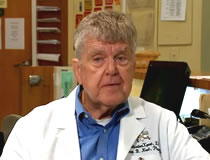August 14th, 2015
Diagnosing Headache: Patient, Provider Communication is Key
Diagnosing Headache: Patient, Provider Communication is Key
August 12, 2015
Diagnosing Headache: Patient, Provider Communication is KeyDiagnosing Headache: Patient, Provider Communication is Key
A study recently presented at the American Headache Society's Annual Scientific Meeting reviewed data on the effectiveness of office visit for patients who present with a chief complaint of headache. The study, presented by Richard B. Lipton, MD, of the Montefiore Headache Center, revealed that an “average [clinic] encounter only lasted about 11 minutes” with mostly close ended questions. This leads to less dialogue and may in turn lead to a less accurate diagnosis, leaving patients without the proper tools to manage their disease. The results shed light on a big problem in headache medicine, where a lack of communication between provider and patient can result in incorrect or no treatment at all for headache.
Differential Diagnosis
One of the most important elements to proper management of a headache patient is an accurate diagnosis. For many patients with primary headaches, their physical examination will be essentially normal; therefore an accurate and thorough history is of the utmost importance. An important task during the first visit is to rule out secondary causes for headaches. Many secondary causes, including aneurysms or tumors, may present with headaches that have features of a primary headache, including migraine. It is very important to look for ‘red flags' or elements of the history and exam that may point to another cause.
SNOOP is a helpful mnemonic to guide physicians during the exam1:
Systemic symptoms: fever, weight loss, or the presence of secondary risk factors that predispose a patient to secondary headaches, including someone in an immunocompromised state (ex: HIV or cancer) requires further work up.
Neurological signs or symptoms: finding a papilledema on fundoscopic exam that may signal increased intracranial pressure, for example, warrants a comprehensive neurological exam following the first visit.
Old age: anyone presenting with first onset headache after age 50 warrants a work up for secondary causes.
Onset: anyone with a headache that is quick or sudden in onset, sometimes described as “thunderclap,” requires an urgent work up.
Pattern: those with a remarkable change in the frequency, severity, or type of headache usually require further work up.
Diagnosing Primary Headache
Once secondary headaches are ruled out, it is important to make an accurate diagnosis of the primary headache. The first point of contact for many patients with headaches is their primary care physician or a general neurologist, therefore it's essential to become familiar or have access to the International Classification of Headache Disorders (ICHD), now in its 3rd Edition2.
Some of the most important questions to ask your patient include:
Location of the headache/radiation: Certain headaches have characteristic patterns of location and radiation.
Ex: occipital neuralgia typically begins in the occipital region (near the occipital notch) and can radiate forward, sometimes becoming retro-orbital
Laterality: Does a patient's headaches change sides or stay strictly unilateral from day to day.
Ex: Hemicrania Continua is a primary headache where a patient describes headaches on only one side of their head ever.
Headache characteristics: Duration and type of pain (ex: throbbing, pulsating, stabbing, etc.) is one of the most important questions to ask since most diagnoses are based on the quality and time profile of each headache episode.
Associated Symptoms: Does the patient experience other symptoms besides pain during the headache? Symptoms like lacrimation, rhinorrhea, and miosis can help point to a certain diagnosis.
Pattern: The pattern of headaches can also point to a diagnosis.
Ex: Cluster headaches tend to occur in certain seasons and during the same time each day.
What helps and hurts: This is especially valuable in headaches that are related to intracranial pressure. Low-pressure headaches may worsen with sitting up while the opposite is true with high pressure headaches, like Idiopathic Intracranial Hypertension.
Self-Treatment: This is often an overlooked question, but important to ask. In addition to their other medications, patients may be overusing medications to treat headaches that may be causing medication overuse headaches. They may not list many over-the-counter medications since they may not consider them as typical “medications.”
The majority of patients who come to their doctor with complaint of headaches will have a diagnosis of migraine, as this is the most common primary headache. For these patients, (as well as most other patients with primary headaches) it is important to ask about the following:
Aura: This can potentially limit medication choices. These patients also need to be advised about use of birth control and possible vascular risks.
Triggers: Many patients are able to find environmental precipitants for their migraines, with stress and hormonal effects found to be among the most common.
Number of headache days: The distinction between episodic and chronic headaches can change management options. It's useful to ask patients to keep a headache diary, noting the severity of headaches, medications they took to treat their headache, and possible patterns or triggers. This can be helpful in later appointments to determine if a new prophylactic medication is working or if a patient is over-medicating with abortive medications.
Scores: It can be helpful to use developed questionnaires during follow-up to more objectively assess if a patient is improving. The MIDAS score3 assesses how many days of headache have affected daily living and function, and can be useful in deciding when to start or switch prophylactic medications.
Communication is Key
Perhaps the most important part of examining a headache patient is allowing them to tell their story. Ask open-ended questions so patients feel comfortable telling you what bothers them most. After all, some patients may have headaches daily but only want treatment for their most severe ones. For many, headache is their body's way of manifesting emotional or psychological pain. This is important to uncover since, if left untreated, patient's headaches will not improve.
That being said, primary headaches, including migraines, are a neurological disease and patients and their symptoms should not be disregarded, as this will likely lead to non-compliance and frustration on the part of the patient. Overall, treating headaches or other pain conditions requires collaboration and transparency between the patient and provider to come to a diagnosis and accompanying solution.
References
Dodick DW. Diagnosing headache: clinical clues and clinical rules. Adv Stud Med. 2003;3(2):87-92.
The International Classification of Headache Disorders, 3rd edition (beta version). Cephalalgia. 2013;33(9):629-808.
Stewart WF, Lipton RB, Dowson AJ, Sawyer J. Development and testing of the Migraine Disability Assessment (MIDAS) Questionnaire to assess headache-related disability. Neurology. 2001;56(6 Suppl 1):S20-8.
- December 4th, 2014
Sulfonylureas Tied to Higher Mortality in DiabeticsRead - August 14th, 2015
Early Opioid Prescription for Back Pain Doesn't Up Risk of Chronic UseRead - January 6th, 2013
Subtle Cognitive Declines Follow MenopauseRead - September 9th, 2012
Vitamin Studies Spell Confusion for PatientsRead - August 17th, 2014
Alcohol Intake and Atrial FibrillationRead
Geriatric Nutrition
Without good nutrition, positive drug therapy outcomes are very difficult to obtain, For the best in Geriatric Nutritional Information
Find out more Optima SolutionsContinuing Education
Each month we will post an analysis of specific aspects of government long-term healthcare regulations.
Find out more


